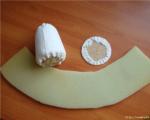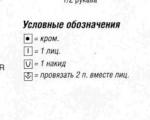Washing knitwear. How to care for knitted items
As you know, knitwear requires special care. Therefore, in order for knitted clothing for home and leisure to serve you longer and not become a household item too quickly, you should adhere to some rules and recommendations for caring for knitted products, namely:
- First of all, you need to read the label on the product to find out the appropriate washing, spinning, and drying modes.
- Knitwear made from cotton, wool, chemical fibers and their mixtures should be washed in warm water up to 40 °C in a soap solution, using mild detergents specifically designed for washing knitwear, otherwise deformation and shrinkage of the items may occur. When washing in the washing machine, use a gentle, delicate wash cycle.
- It is advisable to wash any knitwear by hand and squeeze it rather than rub it, otherwise pilling may appear on it.
- When washing knitwear, you should not use detergents containing all types of bleaches, bioadditives (enzymes), alkalis and their compounds, or colored granules.
- Products of different colors must be washed separately from each other, since lint from one product may stick to another product, and subsequent cleaning will be labor-intensive.
- It is not recommended to soak the product for a long time, no more than 20 minutes. The water should be cool, because in hot water the knitwear shrinks and falls off.
- Products made from artificial and synthetic threads, light-colored products with colored patterns or finishing materials, products with hot-melt patterns, three-dimensional printing or embroidery cannot be soaked or boiled.
- Rinse knitwear first in warm and then in cold water.
- To keep knitted items soft and fluffy, add glycerin to the water when rinsing in a ratio of 1 teaspoon per 1 liter of water. And then rinse again in cold water with the addition of ammonia in the same proportion.
- Knitted items should be wrung out gently, without twisting. It is recommended to briefly wrap the product in a dry towel or sheet.
- Knitwear should be dried flat on a horizontal surface at room temperature. Hanging knitted items is not recommended, as they can stretch and lose their shape.
- It is necessary to iron knitted items from the wrong side and in the direction of the loops with a moderately heated iron, no more than 110 °C.
- Remember, if a knitted product has finishing inserts made of suede, leather or fur, it is better not to experiment and take it to the dry cleaner.
- Knitwear has a loop structure, so when wet, you can slightly change the linear dimensions: lengthen or shorten the sleeves, change the length of the product.
- Due to improper care of knitted products, lumps of matted fibers - pellets - often form on them. It is best to remove pellets with a special brush or a special peeling machine.
- Also, if you do not wear the item for a long time, you should store it folded, since hangers can distort the shape of the knitwear. When storing knitted clothes, it is recommended to use plastic boxes to protect them from bugs and moths.
Caring for cotton products
Cotton fabrics are durable and resistant to high temperatures, and also absorb moisture well. May shrink when washed.
For cotton items, it is recommended to hand wash in warm water at a temperature of 30 - 40 °C, or machine wash on a delicate cycle. For colored products, a powder labeled “Color” is recommended. It is not recommended to use powder with bleaching additives, and such products cannot be bleached.
If the product sheds a lot, it should be washed in cold water and dried flat immediately after rinsing. For rinsing, it is recommended to add salt to the water (1 tablespoon per 10 liters of water).
If the product is slightly colored, just fill it with hot water with the addition of soda and leave for 10 - 12 hours, then wash and rinse several times.
Use the dryer only if recommended by the manufacturer. If you dry a product outdoors, you must take into account that fabrics can fade in the bright sun, and negative temperatures can promote bleaching, which is undesirable for colored and black products.
Ironing is an equally important process, in which you also need to know some subtleties. Cotton is ironed wet from the front side, and if there is embroidery on the fabric, it is ironed from the back.
You can iron cotton with a high temperature iron.
Caring for viscose products
Viscose fiber, when processed differently, can resemble silk, cotton or even wool in its luster and density. Products made from viscose absorb moisture well, but when wet they lose strength, so they require especially careful washing.
Viscose can be washed in a washing machine on a gentle cycle at a temperature of 30 - 40 °C or by hand with washing powder for delicate fabrics or using mild detergents.
Viscose cannot be rubbed, twisted, much less squeezed in a centrifuge.
Viscose items can be hung to dry without wrung out, or they can be rolled into a sheet and gently wrung out.
Iron viscose products damp or through a damp cloth at a temperature of 150 °C, with the iron thermostat set to “silk”.
Products made from viscose fabric can be dry cleaned.
Caring for polyester products
Products made from polyester are easy to wash and dry in a machine and can withstand dry cleaning well. Polyester should be removed from the machine immediately after the drying cycle is complete. When ironing, the iron should be warm, but not hot.
Polyester can be washed in a washing machine at 40°C. At higher temperatures, wrinkles form on the fabric, which are then almost impossible to remove. True, some polyester fibers can withstand temperatures of 60 °C.
White fabrics should be washed with universal powder, colored fabrics with powder for delicate fabrics.
Polyester can only be slightly dried in a machine at a low temperature, but in no case to dryness. In this case, it is necessary to follow the care instructions indicated on the label so that difficult-to-remove wrinkles do not appear.
Polyester does not require ironing, but if it is still needed, it must be ironed with a moderately heated iron through a damp cloth, the iron thermostat should be in the “silk” position.
Polyester items can be dry cleaned.
The best way to care for delicate knitted items is dry cleaning.
Unfortunately, it is not always available. Therefore, we tried to select materials so that knitted items from our line can be washed. An exception is the angora cardigan. Dry cleaning only is recommended for him: the fluffy angora will deteriorate even from the most delicate washing.
Other knitted items can be washed by hand in cool water no warmer than 30°C. If you wash such a thing in hot water, it will shrink, become rough and never return to its previous shape and quality.
If you machine wash, make sure to turn on the delicate cycle. In intensive mode, threads can get caught on the drum, and puffs or holes will appear on your favorite sweater.
HOW TO CHOOSE POWDER AND BALM AND IS IT POSSIBLE TO WHITEN
It is better to wash knitted items with liquid powder for wool and delicate items. This powder will not damage the threads and will maintain their volume.
Add rinse balm to the water. It will help the villi straighten and get rid of static electricity.

Knitwear cannot be bleached. The aggressive substances contained in bleach will not only ruin the color, but can damage the structure of the threads and disrupt the weave, so the item will have to be thrown away.
If a difficult stain appears on a knitted item, take it to the dry cleaner. Dry cleaning does not remove all stains, but it is the only option. If cleaning does not help, the item will have to be thrown away.
HOW TO DRY
Under no circumstances should knitted items be wrung out in the washing machine. A spinning drum is deadly to wool and cashmere. If you don’t want to get out of the machine a shapeless something with strings and holes, do not turn on the spin mode, even the most delicate one. You can wring out the item after washing and rinsing only with your hands, without twisting or pulling.
If you hang a wet turtleneck on a rope, it will pull down under its own weight, and then dry and fix this shape. Proper drying will help maintain the shape of the item and prevent the sleeves or collar from stretching out on the turtleneck.

Turtlenecks, cardigans and other knitted items can only be dried in a horizontal position. Lay a white towel or light cloth on a table or other surface. Lay a turtleneck or cardigan on top, lay the sleeves lengthwise. In this position, the item will retain its original shape.
HOW TO IRON
Knitwear hardly wrinkles, but if the item has been in the closet for a long time, small creases may appear on it. Then it can be ironed from the wrong side with an iron heated to no more than 110°C. This way, the clothes will not be shiny, and creases and iron marks will not appear on them.
Please note that sweaters with dropped sleeves and angora cardigans cannot be ironed.

You should not hang knitted items in the closet on hangers: this will cause them to stretch and lose their shape. Lay the item on the table with the back facing down, fold the sleeves to the right side at the seams, and carefully fold in half along the back. Place the sweater on a shelf, take it out from time to time, air it out and rearrange it.
WHAT IS PEELING AND HOW TO DEAL WITH IT
Peeling is the pellets that appear on knitted items due to friction. If you often touch your bag with your sleeve, or fasten your seat belt in a car, pellets appear at the friction points.
This does not mean that your item is made of low-quality material. Quite the contrary. Peeling is an inevitable companion of knitted, woolen and cashmere items.

But pellets are not a reason to throw away your favorite thing. They can and should be fought.
To do this, buy a pellet removal machine at any electronics store.
It costs around 1000 rubles, helps to cut off pellets and does not spoil the item.
Knitted items should be treated regularly to remove pills, without waiting until they turn into a disaster. Over time, the peeling will decrease or disappear altogether, and the item will continue to look like new.

We write about the features of caring for each item on the items page on the website.
The same information is on the labels in the form of special signs and explanations for them.
We hope that we were able to tell you what and how to do to make knitted items last a long time and look like new. Next time we will wash things made of cotton, silk and jeans.
A soft, pleasant knitted item always enjoys popular love. Almost everyone has a couple of favorite knitwear items that they always want to wear. However, even with these advantages of knitwear, it quickly loses its well-groomed appearance. You just have to wash it incorrectly a few times. In this article I will write you tips on how to care for knitted items.
1. To start washing knitted items, you first need to pay attention to the label, which will contain all the recommendations for caring for this item. If it is not there, then read the recommendations below.
2. Pay attention to the composition of this item. If it contains only natural fibers, then you need to wash it by hand or use a manual mode, but if it contains synthetics, then feel free to wash it in a machine on a delicate cycle.
3.If suddenly you do not know the composition of the fabric, then in this case only hand washing will do. The water temperature should be 30-40°. Use only detergents special for this fabric or shampoo. Dissolve it in water, place clothes in a basin and wash with gentle movements. The item must be rinsed until the detergent is completely removed. When changing the rinse water, make sure that the water is the same temperature, and then this thing will not shrink.
4. Wash knitted items on the “delicate” or “wool” cycle. Buy a special laundry bag to wash knitted items in. Fill the machine drum only halfway. Do not use the spin mode or set the speed to the minimum, but add an additional rinse.
5.To dry clothes, lay out a thick terry towel or any fabric that absorbs moisture on a flat surface. Place things on top, straighten them and leave to dry.
6.If the clothes have stretched after washing, immerse the problem areas in hot water and dry again. If the product, on the contrary, shrinks, iron it with the steam function, slightly stretching it along the edges. If pellets appear on clothes, remove them with strips of tape, a special machine or a razor.

7. To refresh clothes and remove the smell of sweat when hand washing, add a pinch of soda to the water when rinsing the last time, and if you need to make the product soft, 1 teaspoon of glycerin.
8.If the knitted item is a little wrinkled, lay it out on the table and spray it with water from a spray bottle - in an hour it will look like it has been ironed.
9. Before loading into the drum of the machine, knitted items must be turned inside out, while buttons and zippers are fastened.
10. Knitted items should absolutely not be dried on a clothesline. A wet product will lose its shape and stretch under the influence of its weight.
Knitted clothing has a lot of positive properties: it is soft, cozy, does not wrinkle, does not fade and does not accumulate static electricity.
Wash
The best solution would be to wash knitted items by hand. Before washing, be sure to look at the stitching sewn to the inside of the garment.
In most cases, the water temperature when washing knitwear should not exceed 30 0 C. After dissolving the gel or powder in warm water, proceed to washing. When washing a knitted item, do not rub it, but rather wring it out.
If you decide to wash your favorite knitwear in a washing machine, choose the most gentle washing mode without spinning, and set the temperature to no higher than 30 0 C. Use special detergents for knitwear and water softeners.
Rinsing
Upon completion of washing, rinse the knitwear in clean water at the same temperature as when washing.
Rinse thoroughly, without leaving any of the smallest particles of detergent on the fibers of knitted clothing, since after drying, they can cause the color of your favorite item to be irrevocably damaged.
Change the water several times. During the last rinse, add an antistatic agent to the water, which gives the product shape and fluffiness.
Drying
After rinsing, gently wring out the knitted clothing and wrap it in a dry towel. It’s very reminiscent of drying after or, isn’t it?
Lay out the washed knitwear on a horizontal surface of a table or floor, first placing plastic film and a dry towel under it.
When wet, you can slightly change the linear dimensions of a knitted item, lengthen or shorten the sleeves, change the length and width of the product.
Having fixed the knitted item of clothing in the desired position, leave it to dry completely.
Pellets and pills
Due to washing in too hot water, excessive friction of the surfaces of the product against each other during washing, and sometimes for no apparent reason, over time, pills appear on the surface of the knitted item.
Do not despair; know that the cause of pilly appearance can also be a porous structure or weak torsion of the knitwear thread.
How to remove pellets and pills? Elementary - with a razor or a special brush for collecting pellets.
To reduce the chances of pilling, add fabric conditioner to the water when rinsing clothes to soften the fabric fibers.
Ironing
Usually, after proper and competent drying, there is no need to iron a knitted item.
If you still decide to iron the knitwear after washing, do not abuse the ironing temperature and iron the item from the wrong side.
Storage
Place clean and neatly folded knitted items in packaging bags on a separate shelf of the clothing closet.
You can hang knitted clothes on hangers, but only for a short time, otherwise they will stretch and lose their shape.
Let your knitted clothes never fade or stretch! Good luck to you!
When creating a men's or women's wardrobe, it is impossible to do without knitted items that are suitable for all occasions. Knitwear is comfortable to wear, pleasant to the body and therefore has been very popular for many years.
However, knitted items need to be properly cared for, otherwise they quickly lose their appearance and look unpresentable.
How to extend the life of your favorite knitwear?
We erase
 The water temperature when washing knitwear should not exceed 40 degrees Celsius. Such items should be washed by hand or at the “hand (delicate) wash” mark, separating them from other laundry. It is not recommended to use bleaches. To make knitwear extra soft, you can use special conditioners.
The water temperature when washing knitwear should not exceed 40 degrees Celsius. Such items should be washed by hand or at the “hand (delicate) wash” mark, separating them from other laundry. It is not recommended to use bleaches. To make knitwear extra soft, you can use special conditioners.
Knitted items often form pills, so they should not be subjected to strong friction when washing. To better wash the item, you should first soak it in cool or lukewarm water for a short time.
Drying
 You also need to dry knitwear correctly, otherwise it may become deformed ahead of time. You should avoid twisting knitted clothes; drying them with a hanger is also contraindicated, because the deformation can be so severe that the item will become completely unusable. After washing, the knitwear is carefully wrung out, then laid out horizontally on a dry cloth and carefully wrapped. As the water is absorbed, the fabric is replaced with a dry one and these manipulations are continued until completely dry.
You also need to dry knitwear correctly, otherwise it may become deformed ahead of time. You should avoid twisting knitted clothes; drying them with a hanger is also contraindicated, because the deformation can be so severe that the item will become completely unusable. After washing, the knitwear is carefully wrung out, then laid out horizontally on a dry cloth and carefully wrapped. As the water is absorbed, the fabric is replaced with a dry one and these manipulations are continued until completely dry.
Removing pellets
Unfortunately, even if you care for knitwear correctly, pills may appear on it, giving the product an unkempt appearance. They need to be removed from time to time. This can be done using a special machine, brush or manicure scissors. You can use a safety razor, but you need to do this very carefully so as not to damage the product and not to injure yourself. But pulling out the pellets with your hands is undesirable - there is a risk of irreparably stretching the product.
Iron and steam
You also need to iron knitwear correctly so as not to damage its structure. You should act very carefully, turning the product inside out. The iron should glide over the surface smoothly and weakly, with a barely noticeable touch. It is recommended to turn on the steam supply, because the process of ironing knitted items is essentially steaming. Embossed, three-dimensional patterns should not be ironed, so as not to spoil them.
Storage rules
 Knitwear also needs to be stored correctly. You cannot place it on hangers - the products may stretch out and lose their original appearance. It is best to carefully fold things and place them on the shelves of the closet, after placing them in special bags with mini-containers that absorb moisture and foreign odors.
Knitwear also needs to be stored correctly. You cannot place it on hangers - the products may stretch out and lose their original appearance. It is best to carefully fold things and place them on the shelves of the closet, after placing them in special bags with mini-containers that absorb moisture and foreign odors.



